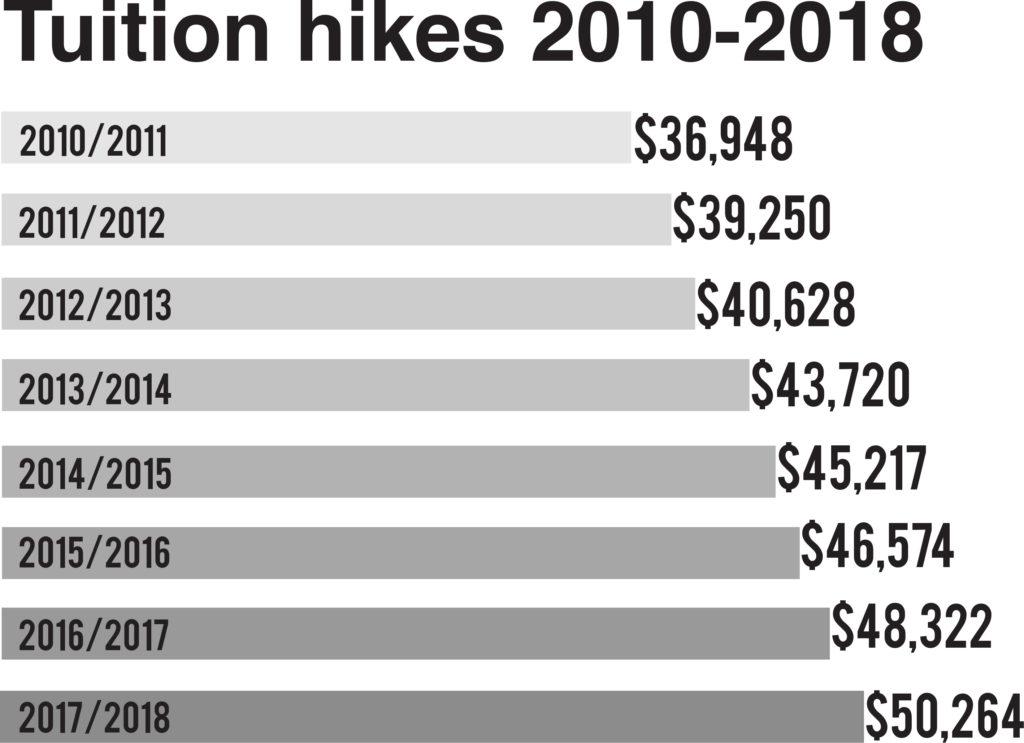
On Jan. 12, Grinnell College announced a 3.91 percent increase in the comprehensive fee, which includes tuition, fees, room and board, bringing the total cost to 63,114 dollars for the upcoming 2017-18 academic year. The increase came nine months after Warren Buffett, a former trustee of the College, strongly criticized that despite a major growth in the endowment, Grinnell’s tuition has consistently risen. The rate of growth of the comprehensive fee is down slightly from the previous year, in which there was an increase of 4.01 percent.
The Board of Trustees approved the increase in December. According to Kate Walker, Vice President for Finance and Treasurer, the College arrived at the comprehensive fee by looking at three different factors.
“First and foremost we look at our mission and how we can deliver programs that are mission-related. That’s really important. Then we also look at what’s going in the marketplace, just in terms of thing like what are our peer institutions doing, what kind of pushback are we getting in the economy … And then the third is financial sustainability.”
This year, the tuition hike was driven by increases in faculty compensation. Walker explained that the College has been engaged in a multi-year process of significantly increasing faculty pay to attract and retain high quality professors. In addition, the rising cost of maintaining dorms was another cause of the price increase.
The College decided to increase the comprehensive fee despite Buffett’s comments last April, when he said, “I was the trustee of a college that saw the endowment go from 8 million dollars to over a billion, and I didn’t see the tuition come down and I didn’t see the number of students go up,” at Berkshire Hathaway Inc.’s annual meeting, as reported in Bloomberg.
Buffett was correct on the first two counts — tuition has consistently gone up, and the endowment was valued at 1.79 billion dollars in 2015. However, enrollment is currently at around 1,700, which is roughly 60 percent higher than it was in 1968, the year Buffett joined the Board of Trustees.
According to Walker, President Raynard Kington reached out to Buffett following his comments, and this led to a meeting in Omaha, which the College’s former president George Drake also attended.
“Kington and Drake … shared compelling evidence with Buffett demonstrating that Grinnell is not stockpiling its endowment, but is in fact using it to support its students,” Walker wrote in an email to The S&B. “[They] provided data showing … [that] scholarships funded through the College’s endowment have also increased. Student debt has remained consistently very low, with total student debt for last year’s graduates averaging under 20,000 dollars … Last, but not least, Drake and Kington explained that we are responsibly managing the endowment to preserve our ability to meet the financial needs of qualified students for generations to come.”
According to Walker, Buffett welcomed the response to his comments in the Bloomberg article.
“Buffett thanked Kington and Drake for setting him straight … He went on to applaud our commitment to financial accessibility and acknowledged the endowment’s essential role in meeting that commitment,” Walker wrote.
Among students and their families, especially those on financial aid, each year’s tuition increase often leads to worries that attending the College may become unaffordable for them. However, according to Brad Lindberg, Director of Financial Aid, the College remains committed to ensuring that a Grinnell education is affordable for everyone.
“Students who qualify for need based financial assistance will receive financial aid from Grinnell to assist them with covering the cost increase,” Lindberg wrote in an email to the S&B. “The financial aid offered to need-based applicants will be adjusted depending upon each family’s unique financial situation.”
Lindberg is cognizant that, while nationally median wages are now rising at around 2 percent annually, some students have families whose incomes are stagnant or dropping.
“My best advice to families who are experiencing circumstances that limit their ability to afford Grinnell, such as a decrease in income, is to reach out to our office,” Lindberg wrote. “We will work with each family to ensure we have the information necessary to produce an appropriate aid package.”
Although many students see the increase as substantial, Walker stresses that Grinnell continues to perform well among the 16 schools against which it compares itself to, all other private liberal arts colleges. Among these ‘peer institutions,’ as they are known, Grinnell’s comprehensive fee is lower than all but two.
Walker noted that it is important to consider what students actually pay when evaluating the comprehensive fee.
“Very few students pay Grinnell’s ‘sticker price’ — less than 15 percent of the student body. When that is taken into consideration, the average net tuition per student is less than 20,000 dollars per year.”





















































